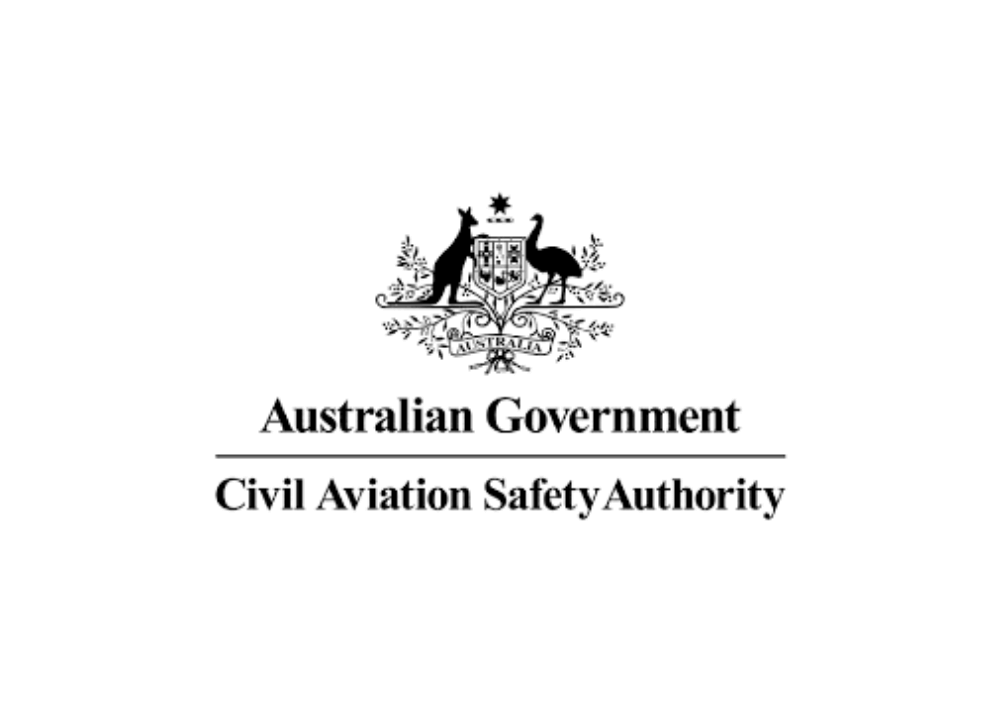CHAPTER 9
Division 4 Obstacle lighting
9.27 Artificial objects and structures
(1) Subject to subsection (2), for a runway intended to be used at night, the following artificial objects or structures are hazardous obstacles and must be provided with obstacle lighting:
(a) an object or structure that extends above the take-off climb surface within 3 000 m of the inner edge of the take-off climb surface;
(b) an object or structure that extends above the approach or transitional surface within 3 000 m of the inner edge of the approach surface;
(c) an object or structure that extends above the applicable inner, conical or outer horizontal surfaces;
(d) an object or structure that extends above the obstacle assessment surface of a T-VASIS or PAPI;
(e) an object or structure in the vicinity of a taxiway, an apron taxiway or a taxilane, that is a hazard to aircraft using the taxiway, apron taxiway or taxilane, except that obstacle lights must not be installed on elevated ground lights or MAGS.
(2) For paragraph (1) (e):
in the vicinity of means in the 5% plane:
(a) originating laterally from the edge of the graded section of the taxiway strip or the edge of the graded portion of the runway strip; and
(b) whose origin is ground level at the edge of the graded portion of the runway or taxiway strip.
(3) Despite subsection (1), CASA may determine in writing, following an assessment, that a hazardous obstacle may remain unlit because it is:
(a) shielded by another object or structure that is already lit; or
(b) does not present a significant hazard to aviation safety.
(4) Despite subsection (1), CASA may determine in writing, following an assessment:
(a) that an object or structure on, or within the immediate vicinity of, the aerodrome is a hazardous obstacle; and
(b) what, if any, lighting is required for that hazardous obstacle.
Note Owners of tall buildings or structures whose summit is below the obstacle limitation surfaces, or that is less than 100 m above ground level, may, of their own volition, provide obstacle lighting to indicate the presence of such buildings or structures at night. To ensure consistency, avoid confusion to pilots, and further the interests of safety both in the air and on the ground, such obstacle lighting should conform with the standards specified in this MOS.
(5) Obstacle lighting may be used during the day instead of obstacle marking.
(6) Obstacle lighting must operate throughout the hours of darkness unless it is within the aerodrome boundary and activated by a PAL.
9.28 Natural obstacles
Note Natural obstacles such as terrain and vegetation are normally extensive. If they infringe an OLS, the need for obstacle lighting will be assessed by CASA on a case by case basis.
If CASA so directs in writing, obstacle lighting must be provided for natural obstacles that infringe an OLS as follows:
(a) if the natural obstacle is located within the approach area — the portion of the obstacle within the approach area must be lit in the same manner as artificial objects or structures;
(b) if the natural obstacle is located outside the approach area — the highest features, and the prominent features, of the natural obstacle must have obstacle lighting.
9.29 Temporary artificial obstacles
At night, or in poor visibility conditions, temporary artificial hazardous obstacles in the approach area or on the movement area must be lit:
(a) with red obstacle lights; and
(b) so that the lights clearly mark the height, extremities and extent of the obstacle.
9.30 Types of obstacle lighting and their use
(1) The following types of obstacle lights must be used, in accordance with this MOS, to light hazardous obstacles:
(a) low-intensity;
(b) medium-intensity;
(c) high-intensity;
(d) a combination of low, medium or high-intensity.
(2) Low-intensity obstacle lights:
(a) are steady red lights; and
(b) must be used on non-extensive objects or structures whose height above the surrounding ground is less than 45 m.
(3) Medium-intensity obstacle lights must be:
(a) flashing white lights; or
(b) flashing red lights; or
(c) steady red lights.
Note CASA recommends the use of flashing red medium-intensity obstacle lights.
(4) Medium-intensity obstacle lights must be used if:
(a) the object or structure is an extensive one; or
(b) the top of the object or structure is at least 45 m but not more than 150 m above the surrounding ground; or
(c) CASA determines in writing that early warning to pilots of the presence of the object or structure is desirable in the interests of aviation safety.
Note For example, a group of trees or buildings is regarded as an extensive object.
(5) For subsection (4), low-intensity and medium-intensity obstacle lights may be used in combination.
(6) High-intensity obstacle lights:
(a) must be used on objects or structures whose height exceeds 150 m; and
(b) must be flashing white lights.
(7) Despite paragraph (6) (b), a medium-intensity flashing red light may be used if necessary to avoid an adverse environmental impact on the local community.
9.31 Location of obstacle lights
(1) This section applies for any hazardous obstacle that must be provided with obstacle lighting, as illustrated in Figures 9.31 (1)-1, 9.31 (1)-2, 9.31 (1)-3 and 9.31 (1)-4.
Note For objects or structures that must be provided with obstacle lighting, see sections 9.27, 9.28 and 9.29.
(2) Obstacle lights must be located:
(a) as close as possible to the top of the object or structure; and
(b) in such numbers, and in such arrangements, as to ensure that the lights clearly indicate at least the points or edges of the object or structure that are highest above the obstacle limitation surface.
(3) Subject to subsection (4), for the following objects or structures:
(a) a structure to the top of which an appurtenance is attached, for example, a lightning rod, flag, antenna, or aerial;
(b) a structure from at or near the top of which a contaminating substance is emitted, for example, smoke, gas or fumes;
the top lights must be placed as close to the top of the structure as is consistent with minimising the likelihood of visual obstruction from:
(c) the attachment; or
(d) the emissions.
Note Normally, the lights should be located 1.5 m to 3 m from the top of the structure.
(4) If an appurtenance, for example, a lightning rod, flag, antenna, or aerial, on a tower-like structure (including an antenna):
(a) extends more than 12 m above the structure; and
(b) is such that it is impossible to attach a high-intensity obstacle light to the top of the appurtenance;
then the high-intensity obstacle light must be attached to the highest possible point of the appurtenance.
(5) For the following:
(a) an extensive object or structure;
(b) a group of closely-spaced objects or structures;
the obstacle lights must be located in such numbers, and in such arrangements, as to ensure that the lights clearly indicate at least:
(c) the points or edges of the object or structure that are highest above the obstacle limitation surface; and
(d) the general definition and extent of the object or structure; and
(e) if 2 or more edges are at the same height — the edge nearest to the runway threshold.
(6) For subsection (5):
(a) if low-intensity lights are used — the lights must be spaced at longitudinal intervals not exceeding 45 m; and
(b) if medium-intensity lights are used:
(i) the lights must be spaced at longitudinal intervals not exceeding 900 m; and
(ii) at least 3 lights must be displayed as a line of lights, horizontally on the side of an extensive object or structure that is nearest to the runway threshold.
(7) Shielding of the downward component of obstacle lighting is permitted, and if used must be such that:
(a) no more than 5% of the nominal light intensity is emitted at or below 5 degrees below horizontal; and
(b) no light is emitted at or below 10 degrees below horizontal.
(8) Subject to subsection (9), for wind turbines in a wind farm, medium-intensity obstacle lights must:
(a) mark the highest point reached by the rotating blades; and
(b) be provided on a sufficient number of individual wind turbines to indicate the general definition and extent of the wind farm, but such that intervals between lit turbines do not exceed 900 m; and
(c) all be synchronised to flash simultaneously; and
(d) be seen from every angle in azimuth.
Note This is to prevent obstacle light shielding by the rotating blades of a wind turbine and may require more than 1 obstacle light to be fitted.
(9) If it is physically impossible to light the rotating blades of a wind turbine:
(a) the obstacle lights must be placed on top of the generator housing; and
(b) a note must be published in the AIP-ERSA indicating that the obstacle lights are not at the highest position on the wind turbines.
(10) If the top of an object or structure is more than 45 m above:
(a) the surrounding ground (ground level); or
(b) the top of the tallest nearby building (building level);
then the top lights must be medium-intensity lights, and additional low-intensity lights must be:
(c) provided at lower levels to indicate the full height of the structure; and Authorised Version F2020C00797 registered 04/09/2020
(d) spaced as equally as possible between the top lights and the ground level or building level, but not so as to exceed 45 m between lights.
(11) If high-intensity obstacle lights are used:
(a) on an object or structure that is not a tower supporting wires or cables — the spacing between the lights must not exceed 105 m; and
(b) on an object or structure that is a tower supporting wires or cables — the lights must be located on the tower as follows:
(i) at the top of the tower;
(ii) at the point of the tower that is the lowest level of the catenary of the wires or cables;
(iii) at approximately midway between the 2 levels referred to in subparagraphs (i) and (ii).
Note In some cases, paragraph (b) may require the bottom and middle lights to be located off the tower on stand-alone supports.
(12) For subsection (11):
(a) the number and arrangement of lights at each level mentioned in subparagraphs (11) (b) (i), (ii) and (iii) must be such that the object or structure is indicated from every angle of azimuth; and
(b) if a light would be shielded in any direction by an adjacent object or structure, the light so shielded may be omitted, provided that such additional lights are used as are necessary to retain the general definition of the object or structure.
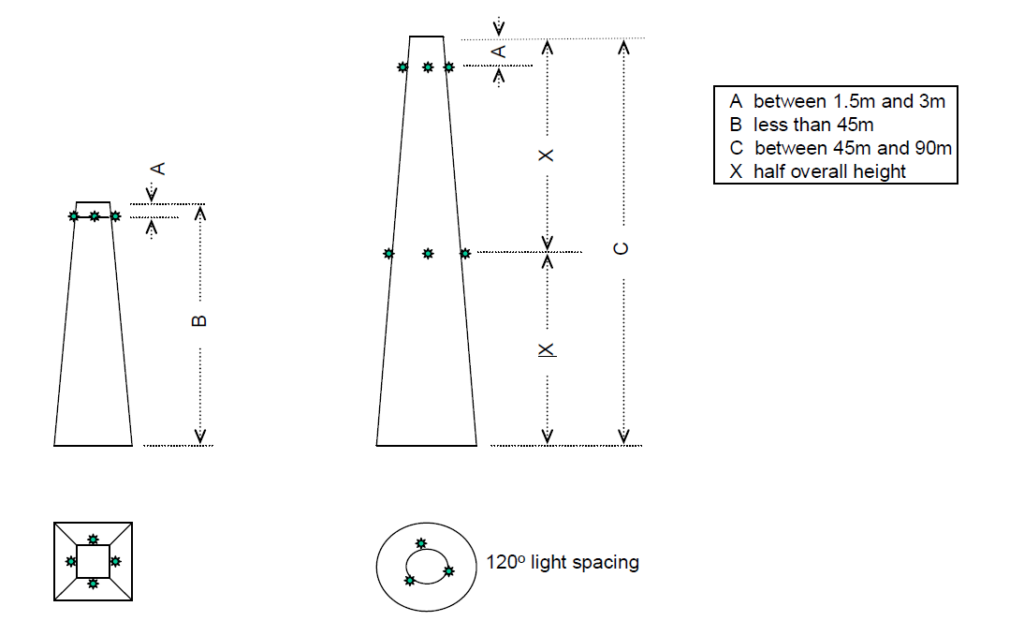
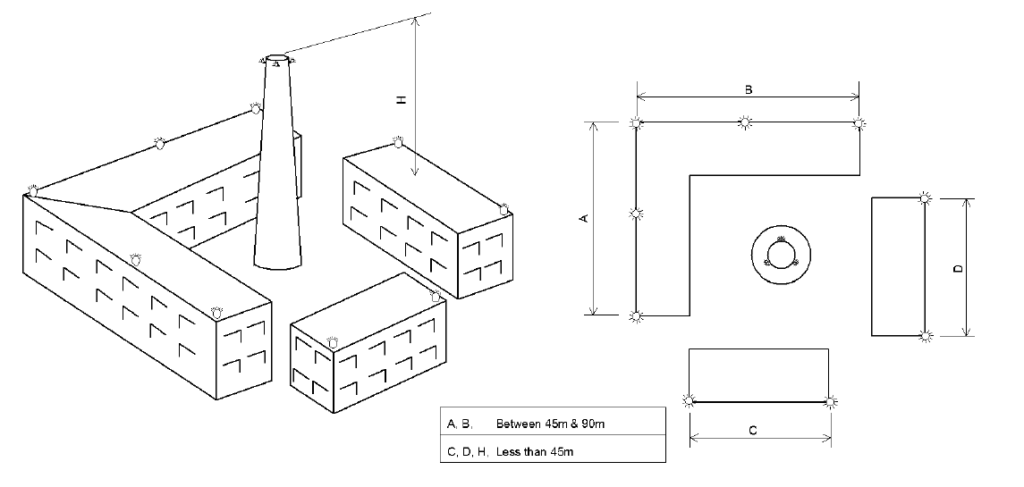
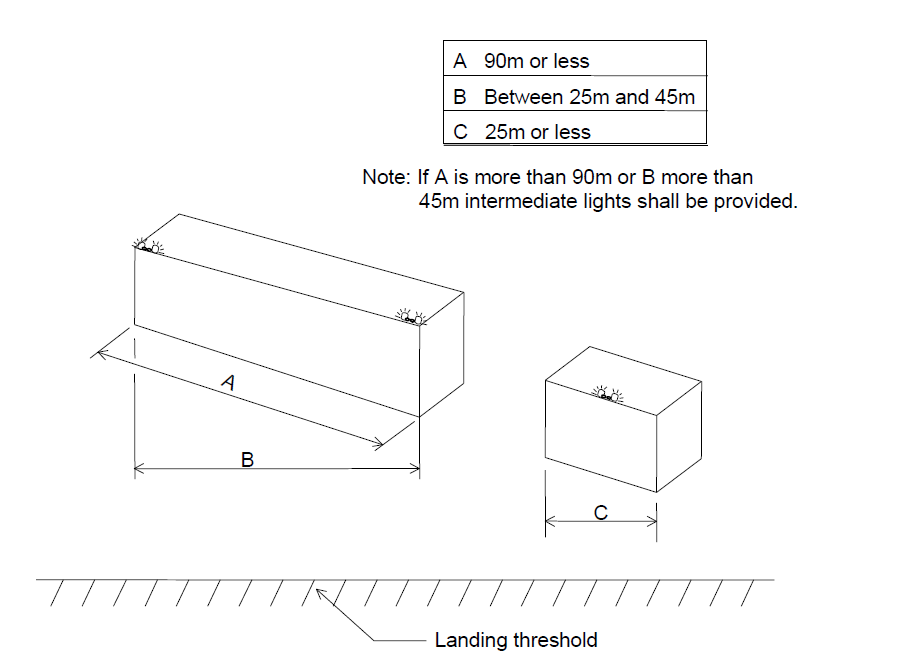
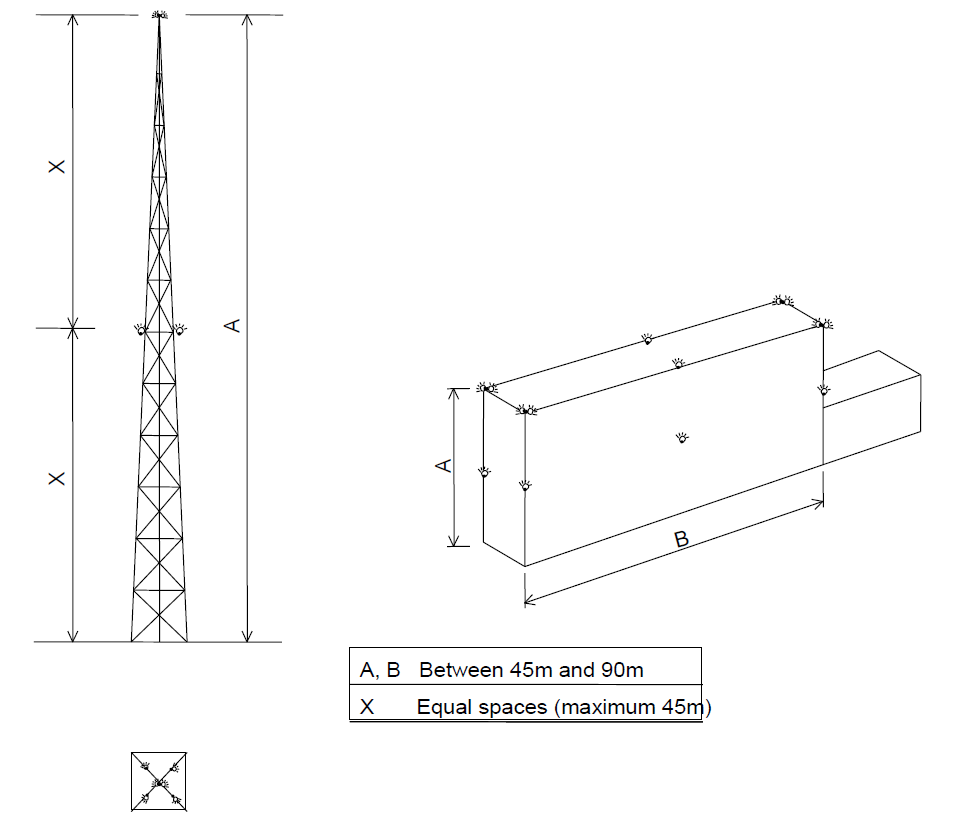
9.32 Characteristics of low-intensity obstacle lights
(1) Low-intensity obstacle lights must have the following:
(a) fixed lights showing red;
(b) a horizontal beam spread that results in 360-degree coverage around the obstacle;
(c) a minimum intensity of 100 candela (cd);
(d) a vertical beam spread (to 50% of peak intensity) of 10 degrees;
(e) a vertical distribution with 50 cd minimum at +6 degrees and +10 degrees above the horizontal;
(f) not less than 10 cd at all elevation angles between –3 degrees and +90 degrees above the horizontal.
Note The intensity requirement in paragraph (c) may be met using a double-bodied light fitting. CASA recommends that double-bodied light fittings, if used, should be orientated so that they show the maximum illuminated surface towards the predominant, or more critical, direction of aircraft approach.
(2) To indicate the following:
(a) taxiway obstacles;
(b) unserviceable areas of the movement area;
low-intensity obstacle lights must have a peak intensity of at least 10 cd.
9.33 Characteristics of medium-intensity obstacle lights
(1) Medium-intensity obstacle lights must:
(a) be visible in all directions in azimuth; and
(b) if flashing — have a flash frequency of between 20 and 60 flashes per minute.
(2) The peak effective intensity of medium-intensity obstacle lights must be 2 000 ± 25% cd with a vertical distribution as follows:
(a) for vertical beam spread — a minimum of 3 degrees;
(b) at -1 degree elevation — a minimum of 50% of the lower tolerance value of the peak intensity;
(c) at 0 degrees elevation — a minimum of 100% of the lower tolerance value of the peak intensity.
(3) For subsection (2), vertical beam spread means the angle between 2 directions in a plane for which the intensity is equal to 50% of the lower tolerance value of the peak intensity.
(4) If, instead of obstacle marking, a flashing white light is used during the day to indicate temporary obstacles in the vicinity of an aerodrome, the peak effective intensity of the light must be increased to 20 000 ± 25% cd when the background luminance is 50 cd/m² or greater.
9.34 Characteristics of high-intensity obstacle lights
(1) High-intensity obstacle lights are flashing white lights.
(2) The effective intensity of a high-intensity obstacle light located on an object or structure, other than a tower supporting overhead wires or cables, must vary depending on background luminance as follows:
(a) 200 000 ± 25% cd effective intensity at a background luminance above 500 cd/m²;
(b) 20 000 ± 25% cd effective intensity at a background luminance between 50-500 cd/m²;
(c) 2 000 ± 25% cd effective intensity at a background luminance below 50 cd/m².
(3) The effective intensity of a high-intensity obstacle light located on a tower supporting overhead wires or cables must vary depending on background luminance as follows:
(a) 100 000 ± 25% cd effective intensity at a background luminance above 500 cd/m²;
(b) 20 000 ± 25% cd effective intensity at a background luminance between 50-500 cd/m²;
(c) 2 000 ± 25% cd effective intensity at a background luminance below 50 cd/m².
(4) High-intensity obstacle lights located on an object or structure, other than a tower supporting overhead wires or cables, must flash simultaneously at a rate between 40-60 flashes per minute.
(5) High-intensity obstacle lights located on a tower supporting overhead wires or cables must flash:
(a) sequentially in a cycle as follows: first the middle light, next the top light, and last the bottom light; and
(b) with a cycle frequency of 40-60 flashes per minute; and
(c) within a cycle — so that the interval between the flashes of each of the lights mentioned in a row of column 1 of Table 9.34 (5) is as close as possible to the proportion of the cycle time mentioned in the same row in column 2.
| Flash interval between | Proportion of cycle time |
|---|---|
| middle and top light | 1/13 |
| top and bottom light | 2/13 |
| bottom and middle light | 10/13 |
(6) Unless otherwise directed in writing by CASA, the installation setting angles for high-intensity obstacle lights must be in accordance with Table 9.34 (6) so that for an obstacle light at a height mentioned in a row of column 1, the angle of the peak of the light beam above the horizontal is the value mentioned in the same row in column 2.
| Height of light above terrain | Angle of the peak of the beam above the horizontal |
|---|---|
| greater than 151 m | 0° |
| 122 m to 151 m | 1° |
| 92 m to 122 m | 2° |
| less than 92 m | 3° |
9.35 Floodlighting of hazardous obstacles
Note Where the installation of obstacle lights in accordance with this MOS is not possible, or is undesirable for aesthetic or other reasons, floodlighting of obstacles may be an appropriate alternative. However, floodlighting may cause a hazard to pilots and a review and acknowledgment process is required (see subsection 9.35 (1)). In general, floodlighting is not suitable if:
(a) the structure is skeletal, as a substantially solid surface or cladding with satisfactory reflectance properties is required; or
(b) there is high-level background lighting.
(1) Floodlighting may be used for a hazardous obstacle instead of obstacle lights, but only if CASA approves in writing receipt of an aerodrome operator’s explanation of why the installation of obstacle lights is not possible, or is undesirable for aesthetic or other reasons.
(2) If floodlighting is used:
(a) the colour must be white; and
(b) illumination of the object or structure must:
(i) cover all directions of azimuth over the full height portion of the object or structure which needs to be illuminated; and
(ii) be uniform around the circumferences of the object or structure.
(3) For subsection (2), the minimum level of luminance must be 5 cd/m² at all points.
Note Based on a reflectance factor of 50% for white paint, this would require illuminance of at least 10 lux. For concrete with a typical reflectance factor of 40%, the required illuminance would be at least 12.5 lux. Materials with reflectance factors less than 30% are unlikely to be suitable for floodlighting.
(4) For subsection (2):
(a) each floodlight fitting must be located evenly around the object or structure, at not more than 120 degrees from any adjacent floodlight fitting; and
(b) at each location:
(i) there must be at least 2 floodlight fittings; and
(ii) each fitting must be on a separate circuit and capable of continuing to operate following the malfunction of another light.
9.36 Serviceability of obstacle lights
(1) For obstacle lights located within the OLS of an aerodrome, the aerodrome operator must establish an obstacle lights serviceability monitoring program that includes the following elements:
(a) for aerodromes with scheduled international air transport operations during the hours of night — observation of the obstacle lights at least once in every 24 hour period, or such longer period as CASA approves in writing on the basis of the aerodrome operator’s written safety assessment;
(b) for aerodromes with scheduled domestic air transport operations during the hours of night — observation of the obstacle lights at least once in every 48 hour period, or such longer period as CASA approves in writing on the basis of the aerodrome operator’s written safety assessment;
(c) for aerodromes other than those mentioned in paragraphs (a) and (b) — observation of the obstacle lights at least once in every 7 day period;
(d) if a medium-intensity or high-intensity obstacle light is not readily observable for paragraph (a), (b) or (c):
(i) a procedure to ensure that the light is monitored in accordance with the relevant monitoring period specified in paragraph (a), (b) or (c), or such longer period as CASA approves in writing on the basis of the aerodrome operator’s written safety assessment; or
(ii) at an aerodrome occupied by aerodrome personnel — the installation of an automatic light-failure indicator to be monitored by the personnel.
(2) For a hazardous obstacle located within the OLS of the aerodrome, if there is an obstacle light outage then the aerodrome operator must:
(a) immediately request the NOTAM Office to advise pilots of the details of the outage; and
(b) as soon as possible, liaise with the owner of the obstacle light so that the outage is repaired as quickly as possible; and
(c) if the obstacle light is determined by CASA, in writing, as essential for aviation safety:
(i) immediately report the outage to any aircraft that are manoeuvring, or are about to manoeuvre, on an affected runway; and
(ii) immediately close the runway or close the aerodrome, as the case requires, until the outage is repaired; and
(iii) notify CASA as soon as possible of the outage.
Note For CASA determining that an obstacle light is essential for aviation safety, see subsection 7.19 (1).
(3) The aerodrome operator’s aerodrome manual must include the following:
(a) details of, and procedures for, the obstacle lights serviceability monitoring program;
(b) the procedures to be followed when an obstacle light outage occurs;
(c) details of the following:
(i) any CASA approval under paragraph (1) (a), (1) (b) or (1) (d);
(ii) any CASA determination mentioned in paragraph (2) (c).
Reference
Flight Standards Branch, National Operations & Standards Division, Civil Aviation Safety Authority 2020, Part 139 (Aerodromes) Manual of Standards 2019, Australian Government, Civil Aviation Safety Authority, Canberra, viewed 24 October 2020, < https://www.legislation.gov.au/Details/F2020C00797>.

